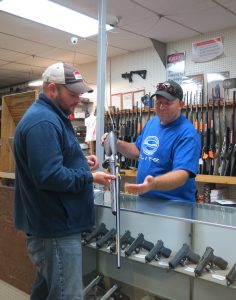It’s tough to sell what you don’t understand. Counter staff may know the locals and have a reputation as a good hunter or a great shot, but if they can’t convey a knowledge of products above that of the customer, the customer is likely to find another resource when it comes to making purchasing decisions.
Sell-through is what keeps revenue flowing and the doors open. Well-trained counter sellers ensure a higher number of likely customers are converted into paying customers. Over time, this is how the store can develop a reputation not only as a supplier of goods, but as a resource for information. This type of word-of-mouth advertising among hunters and shooters is invaluable to the long-term success of the store.
Not only does a properly trained counter staff improve initial sales, it is more equipped to make appropriate add-on-sales suggestions. The power of add-on sales, with a customer already committed to purchasing product from the store, drives up the average transaction amount, and often the profit on each transaction, as the add-on products are typically higher-margin items than the initial product. A counter person, with a firm understanding of products, and his or her features and benefits is capable of making better suggestions with an informed and authoritative tone without seeming pushy. This can be accomplished only through training.
Advertisement — Continue Reading Below
Why Online Training Matters
With technology and products changing almost daily, a consistent ongoing-training regimen is of vital importance. For a store that carries thousands of stock keeping units (SKUs), with hundreds of brands, taking on such a training workload is virtually impossible.
Luckily, as manufacturers and independent sales-rep groups have evolved, they are valuing training as an important part of their role in the relationship with their dealers. A cottage industry of third-party vendors dedicated to helping manufacturers make their training easy and accessible. Using these three resources to supplement the in-store protocol training employees receive is an easy, low-cost way to set your store apart from local competition.
Manufacturers spend considerable time and resources to educate the public about their brand or product. Modern consumers have more outlets to investigate products, which means brands are focused on creating an image that is consistent and impactful to potential customers. A significant factor in how the brand is perceived by consumers is how the brand is communicated by those selling the product.
Advertisement — Continue Reading Below
“It’s vital for sell-through,” remarked Joel Smith, Southeast Regional Sales Manager for Outdoor Group, when asked about training retail employees. “Today’s customers are more sophisticated and knowledgeable than ever. If the customer knows more than the person selling the product, it hurts that employee’s ability to sell.”
Establishing employees as a resource for the products being sold is crucial to the credibility of the shop.
“Fifteen years ago I was on the other side of the counter,” added Smith, who once worked at a nationwide sporting good retail store. “I can count on one hand the number of in-store trainings we had from anyone. We had some computer-based training, but it was voluntary. We were trained on protocol for the store, but the product was never the focus. Now, it’s very much a continuing education process. Especially as you see more brands go towards a certification model for store employees to be able to work on some products or handle specific lines.”
Advertisement — Continue Reading Below
 “They Said It”
“They Said It”
Brad Gross, recently named National Sales Manager for Styrka Optics, echoed Smith’s thoughts.
“Nobody working the counter in a retail shop wants to get themselves over a barrel when a customer asks a question. If there are products the employees aren’t comfortable with, they are naturally going to want to avoid those products. Our job is to give those
employees the tools needed to help consumers make the right product selection.”
I asked Gross what effect overall brand recognition plays in getting retail employees engaged with a brand, and his response was interesting:
Advertisement — Continue Reading Below
“It can cut both ways. People generally fall into two groups: those who are brand loyal and those who experiment. As a newer optics brand, there are some people that look right over Styrka. They might have seen us here or there, but they carry the flag for another brand. Of course I would like to have them as customers, but I can’t hold loyalty against them. But you also have the folks that like trying something new and different. The kind of person that likes having something before their friends do. Those two types of people exist as retail employees, too. We have a quality product, and yes we are new, but that means we have something to talk about. That can work in our favor.”
Gross has a unique perspective, as prior to coming to Styrka he was the principal of his own rep group, M.I.N.K States Marketing, for the last 20 years.
“I’ve gone from spending my time being trained by brands to being at a brand working to train my sales people,” Gross said, adding a chuckle. “Brands and reps have one thing in common: they owe it to their retailers to make sure they have the tools they need to succeed. That means helping to drive sales and maximize profits. The best way to do that is to help the employees come to work as prepared as we can make them.”
Advertisement — Continue Reading Below
As Gross said, independent sales representatives are tasked with being up-to-date on numerous ever-changing brands and being able to speak intelligently about them at all times. A strong sales rep spends a great deal of time receiving training on their brands so they can communicate confidently with shop owners. Since their livelihood depends on shops selling through the product brought into the store, it is important to the rep that the counter employees in the store are able to sell that product as effectively as possible.
Brad Ruddell, President of Mountain States Sports Marketing, offered this when asked about training:
“Our view focuses on the relationships we have with our customers, and building trust that we are there to support them. When you have that level of cooperation, you have a partnership that allows you work with individuals or the entire group.
Advertisement — Continue Reading Below
“We are in contact with our retailers every single day, so training takes on many forms. It might be a 5-minute phone call, chatting about product over a meal before the shop opens or after it closes, ahead of a special promotion or when a new line comes into the store. That makes for thousands of doughnuts and hundreds of pizza over the years when working with retail employees!
“We work hard to be proactive, but if a store needs more help we make it a priority to get there as quickly as possible and have all the support materials their employees need to help make the brand a success.”
Is Online Training Easy To Learn?
The internet has made access to information easier than ever, and recently third-party vendors have used the internet to make access to training more reliable, consistent and timely. Allowing brands and manufacturers to build specific training programs, third-party vendors establish a catalog of brands that retail locations can draw on to keep their employees educated on the latest products and trends. In some cases, the store employees are rewarded with discounts or products for completing that training.
Advertisement — Continue Reading Below
Perhaps the most recognizable name in this space is 3point5.com. Its online, module-based training platform has been one of the most popular training tools for brands and retailers over the last decade. Currently in a bit of a rebrand to eXperticity, 3point5 boasts 750 brand clients and literally 1 million experts using its platform. Because the training is online and trackable, metrics are available to show progress of employees and to let brands know what shops, and employees, are working hardest to further their message. Because it is online, it is infinitely flexible and accessible to virtually any interested store or employee.
There are some newer players in the third-party arena, as well. One such platform is Brandlive. It uses an interactive live video platform to deliver timely and specific information from brands to retail employees. Rather than using modules to test on product information (though that option is available), Brandlive creates a high-level of engagement with a relevant-brand employee to those attending the online live-video event. A live feedback mechanism allows for real-time conversation with the on-camera expert — meaning your employee can ask meaningful questions of the sharpest, most knowledgeable member of the manufacturer’s team and get a live result. No phone tag. No guessing. It’s authentic and satisfying and eliminates misinformation greatly.
“It also archives the video for staff who couldn’t tune in live,” added Mac Howard, Vice President of Strategic Markets at Brandlive. “Or if they missed something important during the live broadcast, they can go back and find what they missed.
Advertisement — Continue Reading Below
“Resources are as tight as ever for brands and retailers. Trying to do this type of training in person would use massive amounts of time and money. Those are things neither can spare. By bringing these parties together digitally, we can largely replicate the best parts of the interactions while minimizing cost. It’s really about having access to the right person, the right product and the right messaging at the right time. Whether it’s on a desktop, iPad or smartphone, the event is easily accessible from wherever the employees happen to be.”
Signing Up For Online Training
Currently, access to these training sessions are managed by the brands. Unlike other training programs, it isn’t possible for shops to sign up for the service and access brand training. With more brands being added, ask if the brand you would like to see is using the Brandlive platform. A great deal of time, energy and capital is put into training sales. Customer service staffs and in marketing of products to the consumer. When that consumer arrives at a store front, however, sometimes the biggest breakdown in the educational cycle is the retail employee not realizing the customer is looking to for advice. Sometimes turnover can be a factor. Aside from keeping employees longer, there isn’t much that can be done to eliminate that issue.
You have a number of partners in your business who have a vested interest in seeing your sales staff succeed. Consider using them to your benefit. After all, these partners are all fully capable of assisting you in developing an efficient training schedule. This will create a destination for knowledgeable staff that can help make the best possible purchases.
Source Article from http://www.shootingsportsretailer.com/2017/02/01/online-training-creating-knowledgeable-employees/














